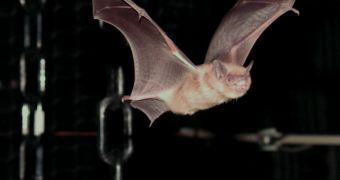Bats are among the most interesting animals to researchers, mostly because they get around using echolocation, while being completely blind. Though they use approximately the same technique as dolphins, theirs evolved separately, and so comparative studies also yield data on how evolution acted in these two species, in addition to how their individual abilities work. Now, experts gain new insight into how bats get around, depending on the type of terrain they are navigating, Wired reports.
Scientists say that it's one thing to fly above plains and between buildings, and an entirely different one to navigate the tight tunnels and confines of caves. Bats oftentimes set up colonies inside intricate cave systems, and they need to navigate extremely cluttered spaces to get from the entrance to their nesting site. Many experts have proposed that echolocation does not function the same all of the time, but thus far no conclusive results to prove this have been obtained. But recently, a team of researchers from the Brown University managed to do just that.
When using echolocation, what the bats do is they emit a series of high-pitched clicks, sounds that have a frequency above what the human ear can make out. The creatures then listen to the reflections sound waves produce on the surrounding locations, and base their future movements on the data they collect in this manner. Their brains have been proven in past investigations to be able to produce a 3D map of the environment using sound waves. The BU team, which included biology graduate student Mary Bates, and her lab leader Jerry Simmons, basically looked at how bats change the pitch of the sounds they are producing in response to the number of obstacles in their environment.
“It’s all a matter of matching the broadcast to the echo. It’s a matter of ignoring or not processing the things that are going to interfere and doing this careful matching of sound to echo,” says Bates, who is also a coauthor for a new paper accompanying the findings, which appears in this week's issue of the esteemed publication Proceedings of the National Academy of Sciences (PNAS). The researchers tested their hypothesis in a small room. They hanged large chains from the ceiling at regular intervals, and then measured the sounds the bats were producing. They found that the creature fine-tunes the frequency of the clicks it emits, in order to get the most accurate feedback.

 14 DAY TRIAL //
14 DAY TRIAL //